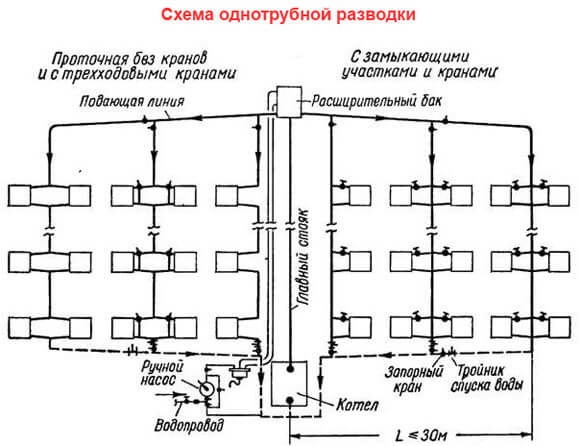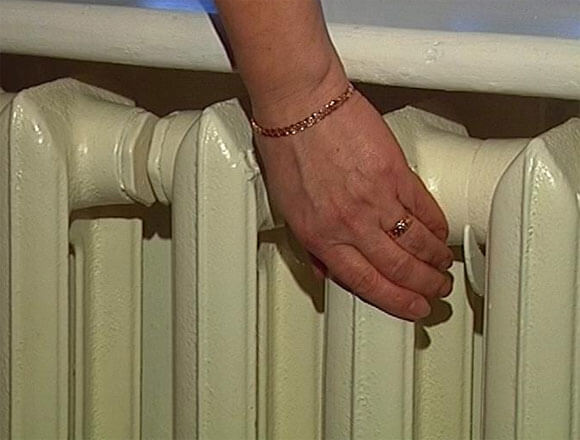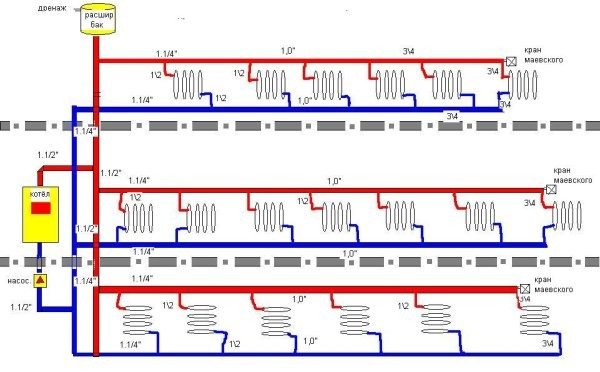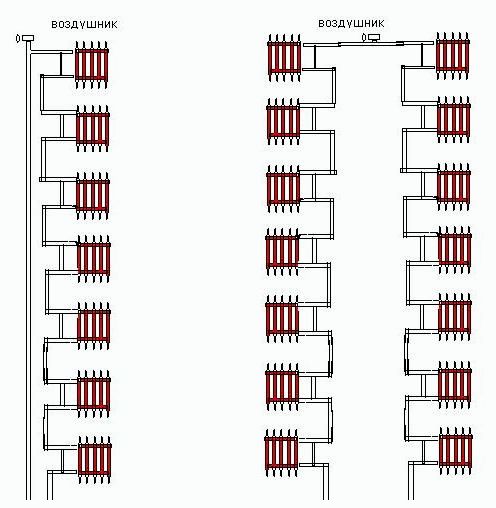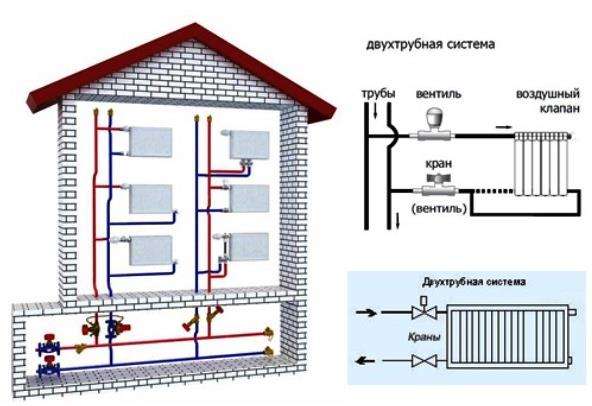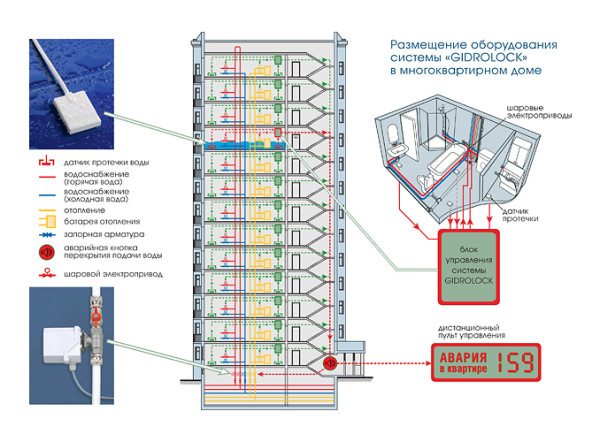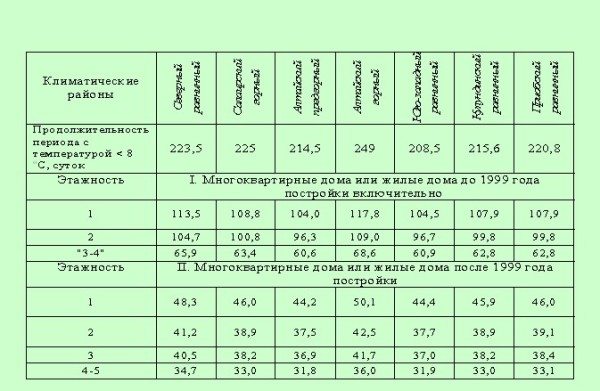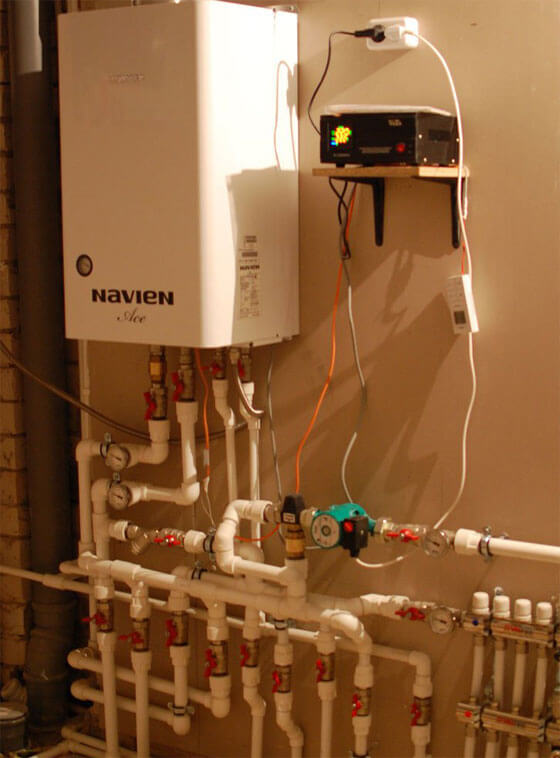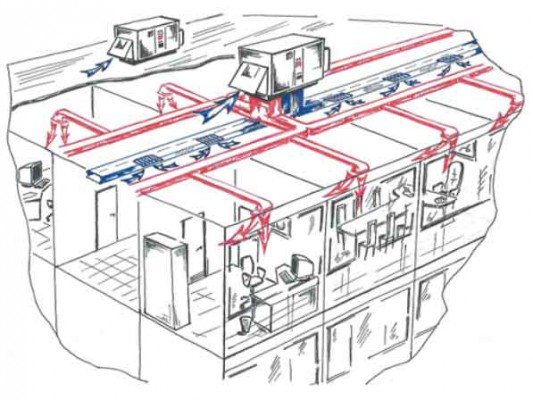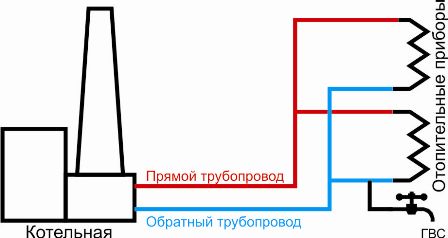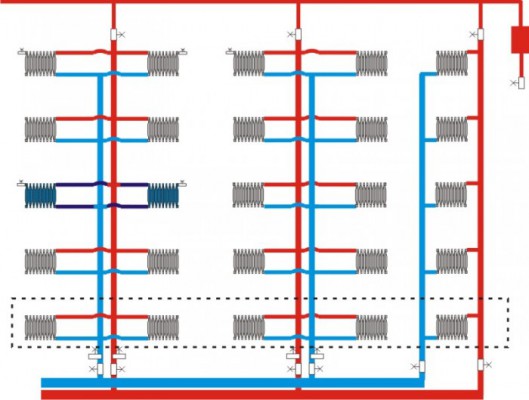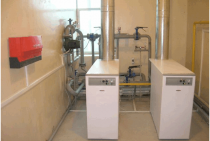Single pipe heating system
Single-pipe heat supply of an apartment building has a lot of disadvantages, the main among which are significant heat losses in the process of transporting hot water. In this circuit, the coolant is supplied from the bottom up, after which it enters the batteries, gives off heat and returns back to the same pipe. For end consumers living on the upper floors, previously hot water reaches a barely warm state.
Another disadvantage of such heat supply is the impossibility of replacing the radiator during the heating season without draining the water from the entire system. In such cases, it is necessary to install jumpers, which makes it possible to turn off the battery and direct the coolant through them.
Thus, on the one hand, as a result of installing a single-pipe heating system circuit, savings are obtained, and on the other hand, serious problems arise regarding the distribution of heat among apartments. In them, the tenants freeze in the winter.
Central heating of apartment buildings
Through the main pipelines, the coolant from the central boiler house is supplied to the heat unit of the apartment building and then distributed to the apartments. In this case, additional adjustment of the degree of hot water supply is carried out directly at the heat point, for which circular pumps are used. This method of supplying the coolant to the end consumer is called independent (for more details: “Centralized heating is both pros and cons“).
In addition, dependent heating systems are used in apartment buildings. In this case, the coolant is transported to apartment batteries without additional distribution directly from the CHP. At the same time, the water temperature is independent of whether it is supplied through a distribution point or directly to consumers.
Who should change batteries is the responsibility of the parties, heating repair
At the same time, the management company must perform its functions in such a way that the state of common house property at any time ensures the uninterrupted provision of high-quality public services. An old, rusted riser pipe is an indicator of a clearly poor level of maintenance work on common property. Find out what is the responsibility of the management company in the article https://realtyinfo.online/6180-osnovnye-obyazannosti-polnomochiya-uk-soglasno-zakonodatelstvu. Who pays for the work For any work you need to pay; no one argues with this. The question is who bears the costs: tenants who live in an apartment with a problematic riser, a management company, or all owners of the premises of this house must pay jointly. This difficult topic causes constant controversy and has various interpretations.
Replacing risers in an apartment building who should do it
How to change the heating in this case? ATTENTION! If you need to change the heating elements in the apartment yourself, equip it with improved batteries, you can do this only with the consent of all the owners of the apartment building. Now the owners of apartments are deploying large-scale work on the arrangement of their homes, changing the layout, the location of the plumbing and heating systems in the room
Installation of new radiators without the consent of the other residents of a multi-storey building is considered arbitrariness. The violator may even be held accountable, especially if the heating is disrupted, its quality has decreased. In the event of a pipe or battery leakage, a change is carried out by the management company without fail. Also, at the expense of the UK, the heating system is modernized if its service life has expired. How to get permission? Older models of heaters may not meet quality requirements.
Providing heat to apartment buildings centralized heating system
As is known, a significant share of the housing stock is provided with heat centrally. And, despite the fact that in recent years more modern heat supply schemes have appeared and are being introduced, central heating remains in demand, if not among the owners, then among developers of multi-apartment housing. However, it should be noted that many years of foreign and domestic experience in the use of such a heating option has proved its effectiveness and the right to exist in the future, provided that all elements are trouble-free and of high quality.
A distinctive feature of such a scheme is the generation of heat outside the heated buildings, the delivery of which from the heat source is carried out through pipelines. In other words, centralized heating is a complex engineering system distributed over a large area, providing heat to a large number of objects at the same time.
Centralized heating system
No one will argue with the fact that the centralized system of heat supply to apartment buildings, in the form in which it currently exists, to put it mildly, is obsolete.
It is no secret that losses during transportation can reach up to 30% and we have to pay for all this. Refusing central heating in an apartment building is a complicated and troublesome procedure, but first, let's figure out how it works.
Heating a multi-storey building is a complex engineering structure. There is a whole set of drains, distributors, flanges that are tied to the central unit, the so-called elevator unit, through which the heating is regulated in an apartment building.
Two-pipe heating scheme.
It makes no sense now to talk in detail about the intricacies of the operation of this system, since professionals are engaged in this and a simple layman simply does not need this, because nothing depends on him here. For clarity, it is better to consider the scheme for supplying heat to an apartment.
bottom filling
As the name implies, the distribution scheme with bottom filling provides for the supply of coolant from the bottom up. Classical heating of a 5-storey building, mounted exactly according to this principle.
As a rule, the supply and return are installed along the perimeter of the building and run in the basement. The supply and return risers, in this case, are a jumper between the highways. This is a closed system that rises to the last floor and descends again to the basement.
Two types of bottling in comparison.
Despite the fact that this scheme is considered the simplest, putting it into operation is troublesome for locksmiths. The fact is that at the top of each riser, a device for bleeding air, the so-called Mayevsky crane, is installed. Before each start, you need to release air, otherwise the air lock will block the system and the riser will not be heated.
Important: some residents of the extreme floors are trying to move the air release valve to the attic so as not to encounter housing and communal services workers every season. This change can be costly.
The attic is a cold room, and if heating is stopped for an hour in winter, the pipes in the attic will freeze and burst.
A serious disadvantage here is that on one side of the five-story building, where the input passes, the batteries are hot, and on the opposite side they are cool. This is especially felt on the lower floors.
Radiator connection option.
Top filling
The heating device in the nine-story building is made on a completely different principle. The supply line, bypassing the apartments, is immediately taken out to the upper technical floor. An expansion tank, an air release valve and a valve system are also based here, which allows cutting off the entire riser if necessary.
In this case, the heat is more evenly distributed over all the radiators of the apartment, regardless of their location. But another problem emerges here, the heating of the first floor in the nine-story building leaves much to be desired. After all, having passed through all the floors, the coolant comes down already barely warm, you can only deal with this by increasing the number of sections in the radiator.
Important: the problem with freezing water on the technical floor, in this case, is not so acute. After all, the cross section of the supply line is about 50 mm, plus in the event of an accident, it is possible to completely drain the water from the entire riser in a few seconds, just open the air vent in the attic and the valve in the basement
Temperature balance
Of course, everyone knows that central heating in an apartment building has its own clearly regulated standards. So during the heating season, the temperature in the rooms should not fall below +20 ºС, in the bathroom or in the combined bathroom +25 ºС.
Modern heating of new buildings.
In view of the fact that the kitchen in old houses does not have a large quadrature, plus it is naturally heated due to the periodic operation of the stove, the permissible minimum temperature in it is +18 ºС.
Important: all the above data are valid for apartments located in the central part of the building. For side apartments, where most of the walls are external, the instruction prescribes an increase in temperature above the norm by 2 - 5 ºС
Heating regulations by region.
About autonomous heating
An autonomous heating system in an apartment building is the dream of many apartment owners, but the process of switching to independent heating is not easy and expensive. These are lengthy legal troubles, and a technical solution to the issue - the correct selection of equipment, installation and commissioning. And the problems associated with the technical implementation of the project are much simpler.
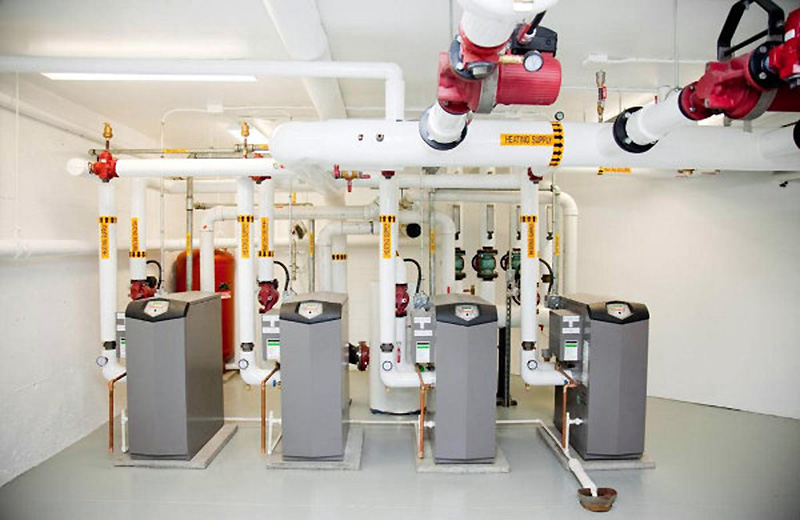
The market of household appliances, including heating, offers the widest range of boilers, radiators, pipes and all kinds of fittings, and in each city there are several dozen specialized companies working in this direction. The organization will not only do all the installation and adjustment work, but also issue all the necessary acts and permits. But the cheapest thing, of course, is to install a heating boiler and lay pipes with your own hands.
The main documents required in order to connect the autonomous heating of an apartment building on your own:
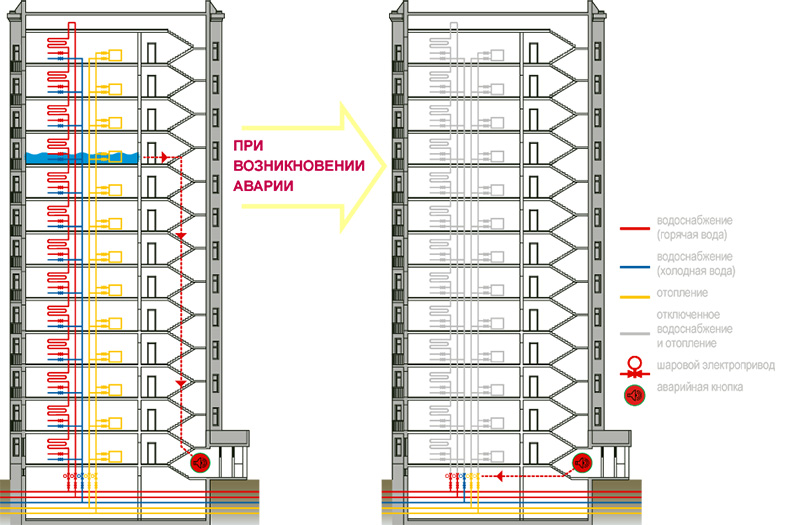
Having issued all the certificates and acts, you can begin the practical realization of a dream and cut off the radiators and pipes of the house or apartment wiring of the DSP. And do not forget to block the heat pipe inlet and seal it. In houses to which a central heating system is connected, it is easier to do this than in high-rise buildings - in apartment buildings, pipe risers were laid through the premises, and in order to dismantle them, you will have to obtain the consent of the neighbors from above and below, and the continuation of the cut pipes - to loop.
Important: Risers that are not connected to your radiators, but run through the apartment, are considered a source of heat. In order not to pay for their thermal energy in the housing office, the pipes should be well insulated - so you can prove that you do not use central heating
Self-replacement
Not many apartment owners wait for major repairs or an emergency. Many decide to replace old equipment with modern ones at their own expense. There are several options for notifying the Criminal Code of their intentions:
- Phone call to housekeeping. The dispatcher, whose number is in the utility bills, will answer in essence when it is possible to carry out the necessary work. In this case, you should ask the dispatcher to introduce himself. This usually speeds up the process.
- Internet sites where you can pose a problem and ask for a solution.Not all, of course, the Criminal Code provide such an opportunity, but already many.
- The usual way is to go to the Criminal Code and leave a request to replace the existing radiators with bimetallic (or others) throughout the apartment. It is better if such applications are submitted by several tenants.
Artist choice
Replacement of heating devices can also be carried out with third-party certified plumbers. On the one hand, it is wiser to order this service in a familiar company, which in any case will turn off the risers. On the other hand, as experience shows, it turns out more expensive. When making a decision, we must remember that the involvement of even very competent plumbers will not relieve the owner of the apartment from liability in case of problems with the system as a whole. Therefore, it is more reliable to replace the heating batteries in the apartment through the Housing Office. And to remind employees of the Criminal Code about this right. For example, the choice of new heaters remains with the tenant. And he chooses them to his taste, taking into account his interior. Exceptions can be technical specifications that must be agreed with professionals - plumbers of the Criminal Code.
Having concluded an agreement with a certain management company, you involuntarily imbue confidence in its specialists in the field of housing and communal services. Therefore, it is easier to immediately be persistent and achieve the replacement of the desired equipment. A huge advantage of cooperation with the Criminal Code is the confidence that new heating devices will be approved, registered, and there will be no complaints about their installation.
Housing and communal services in Russia.
The replacement of the battery, which is common house property, must be paid by the Criminal Code at the expense of the money that you regularly and monthly paid and pay under the article “maintenance and repair of the home” ):
A. RULES FOR MAINTAINING COMMON PROPERTY IN AN APARTMENT BUILDING (approved by Decree of the Government of the Russian Federation of August 13, 2006 N 491):
“…2. The common property includes: ... e) mechanical, electrical, SANITARY ENGINEERING and other equipment located in an apartment building outside or inside the premises and serving more than one residential and (or) non-residential premises (apartments);
6. The common property includes an in-house HEATING system, consisting of risers, HEATING ELEMENTS, control and shut-off valves, collective (common house) heat energy meters, as well as other equipment located on these networks .... "
B. MDK 2-04.2004 "METHODOLOGICAL MANUAL FOR THE MAINTENANCE AND REPAIR OF THE HOUSING FUND" (approved by order of the USSR State Construction Committee in 2004):
LIST OF WORKS INCLUDED IN THE MAINTENANCE PAYMENT
LIST OF WORKS INCLUDED IN THE PAYMENT FOR HOUSING REPAIR (maintenance) ... 1. Central HEATING: Change of individual sections of pipelines, sections of heating devices, shut-off and control valves; … restoration of destroyed thermal insulation.
C. "RULES AND REGULATIONS FOR THE TECHNICAL OPERATION OF THE RESIDENTIAL FUND" (approved by the Regulations of the Gosstroy of the Russian Federation of September 27, 2003 No. 170):
“… II. ORGANIZATION OF MAINTENANCE AND CURRENT REPAIR OF THE HOUSING FUND
LIST OF WORKS RELATED TO CURRENT REPAIRS ... 11. Central heating Installation, REPLACEMENT and restoration of serviceability of INDIVIDUAL ELEMENTS and parts of elements of internal central heating systems, including domestic boilers.» Anastasia! Actually, to replace an EMERGENCY radiator, the management company must buy a new one at the expense of funds “for the maintenance and repair of property”, but for this it is necessary that the appropriate paper be drawn up - an act on the inspection of the radiator, the discovery of an irreparable defect on it and the need to replace it, signed You and the employees of the Criminal Code, which, of course, they will not do.
Anastasia! Politely stick the above text under the nose of the impudent robbers from the Criminal Code and threaten them to send a letter of complaint to the prosecutor's office about their extortion. And if the Criminal Code refuses to replace the battery at the expense of the maintenance and repair of common house property, write letters of complaint to the State. housing inspection, the city administration and the prosecutor's office. Good luck to you!
At whose expense should the heating radiators in the apartment be changed?
We find out the causes of the accident The heating system of the apartment consists of:
- a riser that goes through the toilet;
- supply pipes (return);
- connections between pipes;
- batteries.
No one is immune from the breakthrough of these pipes. This happens often and there can be several reasons for accidents:
old equipment that has become unusable due to a long service life;
careless use of batteries;
improperly installed heating pipes;
it is possible for pipes to break during a routine inspection by the services of the management company, as described above.
How to behave, where to go If an accident did occur, then you should immediately call the housing office and report a breakthrough. If the accident occurred at night, then you need to inform the emergency service. The phone numbers of these organizations should always be at hand.
Dismantling and replacement of the emergency radiator. at whose expense
For example, faulty plumbing. At the same time, the repair of these devices can only be carried out by a company specialist with the consent of the housing office. If the owner changes the plumbing on his own, then when the neighbors are flooded from below, all responsibility will most likely fall only on him. The management company must repair and conduct a scheduled inspection of the heating system in apartments at least 2 times a year.
After verification, an act with the results is issued. If the owners do not let a specialist into the premises, then this equates to improper use of communications.
Replacement of heating batteries in the apartment.
One of the rarest types of repair work in an apartment building is the replacement of a heating battery. The service life of heating devices is from 15 to 40 years. The management companies that have taken over the functions of the ZhEKs carry out measures to change the heating equipment as part of the overhaul program without fail. If desired, apartment owners can change heating batteries unscheduled, but this service is provided on a paid basis.
Individual heating in residential buildings
In addition to the central one, you can find autonomous heating of an apartment in an apartment building, usually such a heat supply is rare and has been installed in new buildings in recent years. Also, local heating systems are used in the private residential sector. With individual heating in an apartment building, it is customary to locate a boiler room either in the building itself in a separate room or close to the house, since it is necessary to regulate the temperature of the coolant in the heating system.
The cost of autonomous heating in an apartment building is rather high, so it is preferable to put into operation one powerful boiler house that can provide heat and hot water to a residential area.
At whose expense is the replacement of heating pipes in case of an accident
The battery broke, the neighbors were flooded - who is to blame What to do when the heating has become unusable and the neighbors have suffered? Where to look for the guilty? First you need to find out whose fault the accident occurred. Who is to blame: the owner of the apartment or the management company that monitors the condition of the heating pipes of the entire house. If the breakthrough of heating occurred through the fault of the owner, then he will compensate for the damage to the neighbors flooded from below.
If it is the fault of the management company, then all the costs of repairing the premises will be borne by it. The Housing Code imposes on the owner of the apartment the obligation to keep the property in proper condition and to monitor the pipes. If necessary, he must make repairs. If the pipes are in poor condition, you need to contact the housing office and call the master. The invitation of a specialist must be formally issued. It is necessary to make an application, which will be registered and the repair time will be set.
Battery replacement via UK
At the time of the accident (for example, the radiator leaked), the replacement of the heating battery is entirely the responsibility of the organization, to whose account the residents transfer money for the maintenance of common property and major repairs. You can not say that such a replacement is free. Cases of coercion to purchase new appliances are not uncommon.It happens that receipts are issued for the cost of work performed.
IMPORTANT! Residents of apartment buildings, regardless of the type of property, do not have to pay anything extra for emergency work. The most frustrating if the battery replacement process is needed in emergency mode during the heating season
And the representatives of the Criminal Code will begin to evade their obligations, referring to the fact that they have neither time, nor employees, or even the radiators themselves. They will remove the old one, put the plugs in and politely offer to wait. Moreover, the terms for replacing faulty radiators have not been established by law. It is important in such a situation to eliminate the cause of the accident. Therefore, in order to wait for nothing, we must act
The most unpleasant thing is if the battery replacement process is needed in emergency mode during the heating season. And the representatives of the Criminal Code will begin to evade their obligations, referring to the fact that they have neither time, nor employees, or even the radiators themselves. They will remove the old one, put the plugs in and politely offer to wait. Moreover, there is no legislative deadline for replacing faulty radiators.
It is important in such a situation to eliminate the cause of the accident. Therefore, in order to wait for nothing, we must act
Actions are recorded in writing. All complaints, statements, acts, any other documents accompanying the process must be in 2 copies. First, a contractor is called to draw up an act. Further, the claim, together with the act, is referred to the Criminal Code. The claim must refer to Decree 491 of the Government of the Russian Federation. The 2nd copy must have the date and signature of the employee of the Criminal Code who accepted the application. It will probably take some time too. In case of refusal, the Housing Inspectorate, when applying there, will take control of the situation and the issue will be resolved. Earlier we wrote about who to complain about the management company.
Selecting the type of radiators
Among several factors that affect the duration of the operation of radiators, the main one is the material of manufacture. The most durable is cast iron, which is used to a greater extent in Soviet buildings. Such batteries require replacement in most cases, as their service life is coming to an end. But this factor is not the only one. The conditions of use also affect the service life:
- Operating pressure of the heat carrier.
- The chemical composition inside the unit.
- Water temperature.
- Possible water hammer.
It is believed that the best time for such work is summer or early autumn. That is, until the actually open heating season. At this time, management companies carry out preventive work in the heating systems of all MKDs. Therefore, it is easier to obtain a work permit.
Classification of district heating systems
The variety of schemes for organizing central heating that exists today makes it possible to rank them according to some classification criteria.
According to the mode of consumption of thermal energy
- seasonal. heat supply is required only during the cold season;
- year-round. requiring constant heat supply.
Type of coolant used
- water - this is the most common heating option used to heat an apartment building; such systems are easy to operate, allow transporting the coolant over long distances without deteriorating quality indicators and controlling the temperature at a centralized level, and are also characterized by good sanitary and hygienic qualities.
- air - these systems allow not only heating, but also ventilation of buildings; however, due to the high cost, such a scheme is not widely used;
Figure 2 - Air scheme for heating and ventilation of buildings
steam - are considered the most economical, because.small-diameter pipes are used to heat the house, and the hydrostatic pressure in the system is low, which facilitates its operation. But such a heat supply scheme is recommended for those objects that, in addition to heat, also require water vapor (mainly industrial enterprises).
According to the method of connecting the heating system to the heat supply
independent. in which the coolant (water or steam) circulating through the heating networks heats the coolant (water) supplied to the heating system in the heat exchanger;
Picture 3 - Independent central heating system
dependent. in which the coolant heated in the heat generator is supplied directly to heat consumers through networks (see Figure 1).
According to the method of connection to the hot water heating system
open. hot water is taken directly from the heating system;
Figure 4 - Open heating system
closed. in such systems, water intake is provided from a common water supply, and its heating is carried out in the central heat exchanger.
Figure 5 - Closed central heating system
At whose expense is the replacement of the heating battery in the apartment through the housing office
ZhK RF), which means that all work on the riser is paid jointly - by all the owners of the premises in the house. Owners of privatized apartments bear the burden of personal expenses only for intra-apartment piping
Since all homeowners pay for the common property, we once again focus on who should change the risers in a privatized apartment, and who pays for the replacement of the risers: it is the management company that changes, all the tenants pay, monthly transferring money to it
How to protect your rights In a planned manner, the replacement of heating risers in an apartment is carried out in the spring and summer, but emergencies can occur at any time of the year. Therefore, without delay, call the emergency team, and then take the application to the housing department to replace the riser.
